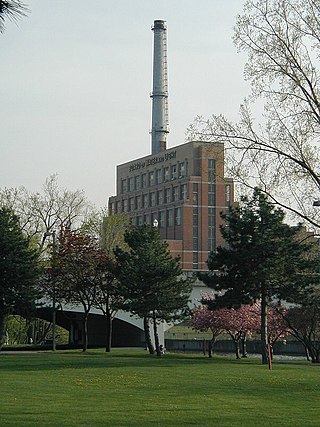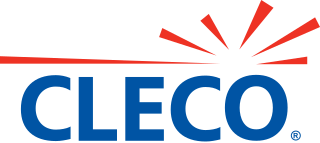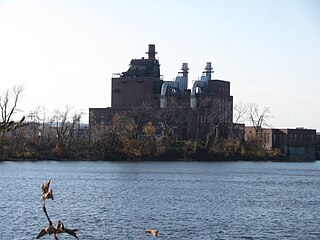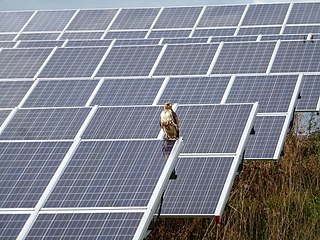
A power station, also referred to as a power plant and sometimes generating station or generating plant, is an industrial facility for the generation of electric power. Power stations are generally connected to an electrical grid.

Cogeneration or combined heat and power (CHP) is the use of a heat engine or power station to generate electricity and useful heat at the same time.

The Manitoba Hydro-Electric Board, operating as Manitoba Hydro, is the electric power and natural gas utility in the province of Manitoba, Canada. Founded in 1961, it is a provincial Crown Corporation, governed by the Manitoba Hydro-Electric Board and the Manitoba Hydro Act. Today the company operates 16 interconnected generating stations. It has more than 527,000 electric power customers and more than 263,000 natural gas customers. Since most of the electrical energy is provided by hydroelectric power, the utility has low electricity rates. Stations in Northern Manitoba are connected by a HVDC system, the Nelson River Bipole, to customers in the south. The internal staff are members of the Canadian Union of Public Employees Local 998 while the outside workers are members of the International Brotherhood of Electrical Workers Local 2034.
Puget Sound Energy (PSE) is an energy utility company based in the U.S. state of Washington that provides electrical power and natural gas to the Puget Sound region. The utility serves electricity to more than 1.1 million customers in Island, King, Kitsap, Kittitas, Pierce, Skagit, Thurston, and Whatcom counties, and provides natural gas to 750,000 customers in King, Kittitas, Lewis, Pierce, Snohomish and Thurston counties. The company's electric and natural gas service area spans 6,000 square miles (16,000 km2).

District heating is a system for distributing heat generated in a centralized location through a system of insulated pipes for residential and commercial heating requirements such as space heating and water heating. The heat is often obtained from a cogeneration plant burning fossil fuels or biomass, but heat-only boiler stations, geothermal heating, heat pumps and central solar heating are also used, as well as heat waste from factories and nuclear power electricity generation. District heating plants can provide higher efficiencies and better pollution control than localized boilers. According to some research, district heating with combined heat and power (CHPDH) is the cheapest method of cutting carbon emissions, and has one of the lowest carbon footprints of all fossil generation plants.

Constellation Energy Corporation is an American energy company headquartered in Baltimore, Maryland. The company provides electric power, natural gas, and energy management services. It has approximately two million customers across the continental United States.
Saskatchewan Power Corporation, operating as SaskPower, is the principal electric utility in Saskatchewan, Canada. Established in 1929 by the provincial government, it serves more than 538,000 customers and manages over $11.8 billion in assets. SaskPower is a major employer in the province with over 3,100 permanent full-time staff located in approximately 70 communities.

Consumers Energy is an investor owned utility that provides natural gas and electricity to 6.7 million of Michigan's 10 million residents. It serves customers in all 68 of the state's Lower Peninsula counties. It is the primary subsidiary of CMS Energy. The company was founded in 1886 and is currently headquartered in Jackson, Michigan.

WEC Energy Group is an American company based in Milwaukee, Wisconsin that provides electricity and natural gas to 4.4 million customers across four states.

JEA Northside Generating Station in Jacksonville, Florida is a major power plant, one of the three power plants owned and operated by JEA, Jacksonville's municipal utilities service. It produces electricity by burning coal and petroleum coke at Units 1 and 2, formerly the largest circulating fluidized-bed combustors, (CFBs), in the world. These combustors, completed in 2002 and rated at 297.5 megawatts each, produce enough electricity to light more than 250,000 households. In addition, Unit ST3 produces 505 megawatts of electricity by burning residual fuel oil and/or natural gas.
Energy recycling is the energy recovery process of utilizing energy that would normally be wasted, usually by converting it into electricity or thermal energy. Undertaken at manufacturing facilities, power plants, and large institutions such as hospitals and universities, it significantly increases efficiency, thereby reducing energy costs and greenhouse gas pollution simultaneously. The process is noted for its potential to mitigate global warming profitably. This work is usually done in the form of combined heat and power or waste heat recovery.
Madison Gas and Electric Company (MGE) is the primary subsidiary of MGE Energy, Inc.. As a regulated utility, it primarily serves the Madison, Wisconsin metropolitan area with electricity, gas and green energy options.

Ottawa Street Power Station is a former municipal electric and steam utility generating station for the Lansing Board of Water and Light in Lansing, Michigan, located on the Grand River in the city's central business district that was redeveloped as corporate headquarters for the Accident Fund Insurance Company of America.

Thor Cogeneration is a planned, but undeveloped, gas-fired cogeneration plant, which was to be built on Seal Sands near Billingham, in County Durham, North East England.

Cleco Corporate Holdings LLC is an electric power company headquartered in the Central Louisiana city Pineville. It operates a regulated electric utility company, Cleco Power, that serves approximately 290,000 retail customers in Louisiana. Cleco also operates an unregulated wholesale electricity business.

REO Town is a district in Lansing, Michigan, United States, located south of downtown. The neighborhood is bordered by West Malcolm X Street to the north; South Cedar Street BL I-96 to the east; West Mount Hope Avenue to the south; and Townsend Street, the Grand River, and South Martin Luther King Jr. Boulevard to the west.

The West Springfield Generating Station, also known by its corporate name EP Energy Massachusetts, LLC, was a fossil-fuel-fired power plant located in West Springfield, Massachusetts. The station was a "peaking" facility, meaning that it primarily operates during peak electrical demand. The facility consisted of two 49-megawatt (MW) combustion turbine generators fueled by natural gas or ultra low-sulphur diesel fuel, one 18 MW jet turbine that was fueled by kerosene, and one 107 MW simple-cycle steam boiler unit burning no. 6 fuel oil, ULSD or natural gas. The station also had a small auxiliary boiler for process and building heat and an emergency back-up generator.

Solar power in Michigan has been growing in recent years due to new technological improvements, falling solar prices and a variety of regulatory actions and financial incentives. The largest solar farm in Michigan is Assembly Solar, completed in 2022, which has 347 MW of capacity. Small-scale solar provided 50% of Michigan solar electricity as recently as 2020 but multiple solar farms in the 100 MW to 200 MW range are proposed to be completed by the middle of the decade. Although among the lowest U.S. states for solar irradiance, Michigan mostly lies farther south than Germany where solar power is heavily deployed. Michigan is expected to use 120 TWh per year in 2030. To reach a 100% solar electrical grid would require 2.4% of Michigan's land area to host 108 GW of installed capacity.
Trafford power station supplied electricity to the Trafford and Stretford areas of Greater Manchester, and to the national grid, from 1929 to 1976. The generating station was built by the Stretford and District Electricity Board which it operated until the nationalisation of the British electricity supply industry in 1948. The 60 megawatt coal-fired station was supplemented in 1952 with an experimental 15 megawatt gas turbine generating set.















